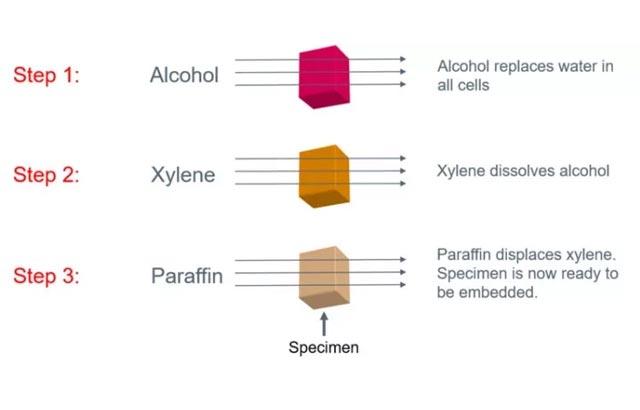
Connective Tissue

Connective tissue is one of the body's four tissue types (others are epithelial, muscle, and nervous tissue). It plays essential, varying roles by holding together, protecting, supporting, and joining organs to tissues.1 The epithelial tissue sits and is padded by the connective tissue while the muscle and nerve tissue are rooted within. Connective tissue surrounds the blood vessels and nerves as they course through the tissue. 2
Connective tissue consists of cells, ground substance (a clear, colorless, viscous fluid or sometimes hardened filling the space between the cells and fibers), and three protein fibers to make up the extracellular matrix. Collagen fibers contain glycoproteins and are the most prominent to provide the tendons and ligaments with strength. Elastic fibers consist of elastin protein and some glycoprotein, and other proteins with the ability to stretch and return to their original shape. Elastic fibers are in the skin, lungs, arteries, veins, elastic cartilage, periodontal ligament, and vertebral column. Made of similar proteins as collagen fibers but long and branching, reticular fibers are throughout the body, particularly in the reticular tissue of the liver, spleen, and lymphatic tissue. 3
Categories of Connective Tissue
All tissues consist of cells, but connective tissue cells are packed loosely within the extracellular matrix.4 Connective tissue comprises two broad categories based on the cells and the extracellular matrix–connective tissue proper and specialized connective tissue.
Connective Tissue Proper includes:
- Loose connective tissue (subcategorized into areolar, adipose, and reticular) contains collagenous, reticular, and elastic fibers with a ground substance. The most widely distributed, the loose connective tissue, joins the cells in other tissues such as muscles, epithelia, and nerves.5 This tissue can be found in most organs and supports immunity, mechanical and metabolic activity.
- Dense connective tissue (dense regular, elastic, dense-irregular) is highly compressed collagenous fibers to make up the walls of large arteries, dermal layer of skin, tendons, and ligaments.
Specialized Connective Tissue includes:
- Bone -Like all connective tissue, bone consists of a mineralized extracellular matrix and ground substance. Bone provides weight-bearing and protective functions. It also stores calcium and phosphate. 4
- Cartilage - (hyaline, fibrocartilage, and elastic). The most common cartilage is hyaline cartilage found in the nose, ribs, trachea, and larynx. Fibrocartilage is the strongest cartilage located in invertebral discs, joint capsules, and ligaments. Elastic cartilage helps maintain shape while providing strength and elasticity in the external ear, epiglottis, and larynx.6
- Blood and Lymph - The blood and lymph systems consist of a liquid extracellular matrix. The blood is responsible for transporting oxygen, carbon dioxide, nutrients, wastes, and salts, defending against harmful microorganisms and blood clotting. The lymph system drains and delivers molecules into the blood, including fat absorbed by the intestine, and carries excess interstitial fluid.7
- Adipose Tissue – Composed of adipocytes or lipid cells, adipose tissue is categorized as white or brown tissue. White adipose tissue is plentiful in the body beneath the skin, around organs, and in the bone marrow. Its purpose is to store energy, insulate, and cushion the body. Brown adipose tissue is found in the fetus and infants along the upper back and helps prevent hypothermia in infants.8
- Reticular Connective Tissue - is made up of reticular fibers (type III collagen) to form a mesh-like, supportive framework for soft organs such as lymphatic tissue, the spleen, and the liver.9 This connective tissue is also found in the bone marrow.
- Embryonic Connective Tissue – is formed in the embryo's development and consists of mesenchyme which matures into the various connective tissues of the body, and mucoid connective tissue, which is a gelatinous substance found in the umbilical cord.10
Connective tissue contributes to restoring fuel and transporting substances in the body. Different types of connective tissue have varying vascularity. Bone, for instance, is highly vascular, while tendons, ligaments, and cartilage have little to no blood supply.11 Due to the lack of blood supply, cartilaginous tissue is slow to heal.
Connective Tissue Diseases
Connective tissue diseases are autoimmune disorders (characterized by autoantibodies) that affect the collagen and elastin proteins. Over two hundred connective tissue disorders can be classified as genetic disorders (Heritable Disorders of Connective Tissue (HDCTs), autoimmune disorders, or cancer. 12 Examples of heritable disorders of connective Tissue are Ehlers-Danlos syndrome (EDS), Epidermolysis bullosa (EB), Marfan syndrome, and Osteogenesis imperfecta. Some common autoimmune connective tissue disorders include Rheumatoid arthritis (which can also be inherited), Scleroderma, Mixed connective tissue disease, Undifferentiated connective tissue disease, Systemic lupus erythematosus, Sjögren's syndrome, and Psoriatic arthritis. Soft tissue sarcoma is a connective tissue cancer that can occur anywhere in the body. 13
Diagnosis of Connective Tissue Diseases
Based on the patient's symptoms, family history, and physical exam findings, a physician may order the following:
- Complete blood count
- Inflammatory markers (Erythrocyte sedimentation rate (ESR) or C-reactive protein (CRP)
- Antinuclear antibodies (ANA). The American College of Rheumatology supports the immunofluorescence antinuclear antibody test using Human Epithelial type 2 (HEp-2) substrate as the gold standard for ANA testing. 14
- Rheumatoid factor
- Imaging tests (X-rays or MRI)
- Urine tests
- Tissue biopsy – performed to determine the diagnosis, organ involvement, and therapy efficacy. 15
- Other first-line tests for differential diagnosis include dsDNA, IgG; Smith/RNP, IgG; Smith (ENA), IgG; SSA 52 and 60, IgG; SSB, IgG; Jo-1, IgG; Scl-70, IgG. 16 (The Choosing Wisely Campaign recommends not ordering ANA subserologies if the ANA is not positive.) 17
Connective tissue is the most abundant tissue in the body that serves to attach, support, protect, insulate, store reserve fuel, and transport substances within the body. 18 Connective tissue disorders are varied and can affect many body areas. Treatment is different with each disease. There is ongoing research on biomarkers to aid in the diagnosis, early detection, prediction of disease progression, and treatment.19 For those with a connective tissue disorder, support and advocacy groups can direct patients and families to resources and services. 20
To learn more about the staining process in the laboratory after a tissue biopsy, visit Special Stains – Which One, How, and Why? Part II: Connective Tissue
About the presenter

Rhondalyn Bomkamp, is an accomplished Director/Nurse Leader with a proven track record of effectively managing complex projects and health system performance improvement initiatives. As a registered nurse, she has experience in Quality and Patient Safety and Project Management/Development in the oncology, cardiac and intensive care arenas. She has strong clinical knowledge and management experience with the ability to recognize opportunities for improvement, coordinate the work of many areas and develop collaborative relationships with diverse groups to facilitate the implementation of change.
References
- Tissue types: MedlinePlus Medical Encyclopedia Image. medlineplus.gov. https://medlineplus.gov/ency/imagepages/8682.htm#:~:text=Overview
- Histology at SIU, connective tissue. histology.siu.edu. https://histology.siu.edu/intro/ct.htm
- Characteristics of Connective Tissue. Medicine LibreTexts. Published July 18, 2018. https://med.libretexts.org/Bookshelves/Anatomy_and_Physiology/Book%3A_Anatomy_and_Physiology_(Boundless)/4%3A_Organization_at_the_Tissue_Level/4.3%3A_Connective_Tissue/4.3A%3A_Characteristics_of_Connective_Tissue
- Vaskovic J. Overview and types of connective tissue. Kenhub. Published October 20, 2020. https://www.kenhub.com/en/library/anatomy/overview-and-types-of-connective-tissue
- Loose Connective Tissue - an overview | ScienceDirect Topics. www.sciencedirect.com. Accessed March 28, 2022. https://www.sciencedirect.com/topics/medicine-and-dentistry/loose-connective-tissue
- Paxton S, Peckham M, Knibbs A. The Leeds Histology Guide. wwwhistologyleedsacuk. Published online 2003. http://www.histology.leeds.ac.uk/bone/cartilage_types.php
- Connective Tissue Supports and Protects - Anatomy and Physiology - OpenStax. openstax.org. https://openstax.org/books/anatomy-and-physiology/pages/4-3-connective-tissue-supports-and-protects
- Hernandez, Anna. Adipose Tissue - What Is It, Location, Function, and More. Osmosis from Elsevier. https://www.osmosis.org/answers/adipose-tissue
- J. Gordon Betts, Young KA, Wise JA, et al. Connective Tissue Supports and Protects. Opentextbc.ca. Published March 6, 2013. https://opentextbc.ca/anatomyandphysiologyopenstax/chapter/connective-tissue-supports-and-protects/
- Connective tissue Supports and Protects | Anatomy and Physiology I. courses.lumenlearning.com. Accessed June 20, 2022. https://courses.lumenlearning.com/suny-mcc-ap1/chapter/connective-tissue-supports-and-protects/#m46049-fs-id1466811
- Payvand Kamrani, Marston G, Jan A. Anatomy, Connective Tissue. Nih.gov. Published January 24, 2022. https://www.ncbi.nlm.nih.gov/books/NBK538534/#:~:text=Loose%20and%20dense%20connective%20tissue
- Connective Tissue Disorders. Medlineplus.gov. Published 2019. Accessed April 8, 2019. https://medlineplus.gov/connectivetissuedisorders.html
- Cancer of the Connective Tissues: Soft-Tissue Sarcoma | HSS. Hospital for Special Surgery. Accessed April 4, 2022. https://www.hss.edu/condition-list_soft-tissue-sarcoma.asp#:~:text=Soft%2Dtissue%20sarcoma%20is%20the
- AMERICAN COLLEGE of RHEUMATOLOGY POSITION STATEMENT SUBJECT: Methodology of Testing for Antinuclear Antibodies. Accessed April 4, 2022. https://www.rheumatology.org/DesktopModules/DnnSharp/SearchBoost/FileDownload.ashx?file=746&sb-bhvr=1
- Ton E, Kruize AA. How to perform and analyze biopsies in relation to connective tissue diseases. Best Practice & Research Clinical Rheumatology. 2009;23(2):233-255. doi:10.1016/j.berh.2009.03.004
- Connective Tissue Disease First Line Panel with Reflex | ARUP Laboratories Test Directory. ltd.aruplab.com. Accessed April 4, 2022. https://ltd.aruplab.com/Tests/Pub/3002463?_ga=2.83754896.763613615.1649082776-1886735722.1648837187
- Yazdany J, Schmajuk G, Robbins M, et al. Choosing wisely: The American College of Rheumatology's top 5 list of things physicians and patients should question. Arthritis Care & Research. 2013;65(3):329-339. doi:10.1002/acr.21930
- Lumen Learning. Connective Tissue | Boundless Anatomy and Physiology. Lumenlearning.com. Published 2019. https://courses.lumenlearning.com/boundless-ap/chapter/connective-tissue/
- Jog NR, James JA. Biomarkers in connective tissue diseases. Journal of Allergy and Clinical Immunology. 2017;140(6):1473-1483. doi:10.1016/j.jaci.2017.10.003
- Connective tissue diseases | Genetic and Rare Diseases Information Center (GARD) – an NCATS Program. rarediseases.info.nih.gov. https://rarediseases.info.nih.gov/diseases/diseases-by-category/27/connective-tissue-diseases
Related Content
Leica Biosystems Knowledge Pathway content is subject to the Leica Biosystems website terms of use, available at: Legal Notice. The content, including webinars, training presentations and related materials is intended to provide general information regarding particular subjects of interest to health care professionals and is not intended to be, and should not be construed as, medical, regulatory or legal advice. The views and opinions expressed in any third-party content reflect the personal views and opinions of the speaker(s)/author(s) and do not necessarily represent or reflect the views or opinions of Leica Biosystems, its employees or agents. Any links contained in the content which provides access to third party resources or content is provided for convenience only.
For the use of any product, the applicable product documentation, including information guides, inserts and operation manuals should be consulted.
Copyright © 2024 Leica Biosystems division of Leica Microsystems, Inc. and its Leica Biosystems affiliates. All rights reserved. LEICA and the Leica Logo are registered trademarks of Leica Microsystems IR GmbH.



